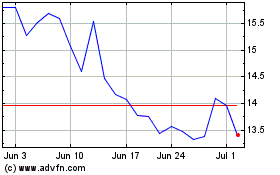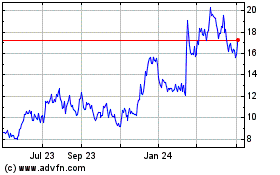Uber Slows Down in Traffic on Its Way to IPO -- WSJ
April 13 2019 - 3:02AM
Dow Jones News
By Eliot Brown
This article is being republished as part of our daily
reproduction of WSJ.com articles that also appeared in the U.S.
print edition of The Wall Street Journal (April 13, 2019).
Uber Technologies Inc. has talked up its expansion into new
businesses beyond ride-hailing, from food delivery to long-haul
trucking. But it can't escape the fierce competition.
The ride-hailing giant's IPO documents made public Thursday show
a company besieged by competitors on all fronts, leading to sharp
declines in revenue growth just as it readies to market itself to
growth-hungry public-market investors.
Faced with a now-formidable U.S. competitor in Lyft Inc. and
many well-funded meal-delivery startups, Uber has had to pour on
subsidies and discounts for riders and drivers in both its main
ride-hailing and meal-delivery businesses.
Uber explained throughout its filing that it faces intensifying
competition around the world, taking a particular toll on the
business in the second half of 2018. The onslaught is so pronounced
that a key measure of revenue growth between quarters has halted
after surging in prior years.
Revenue from ride-hailing -- minus some incentive payments to
drivers and other costs -- was $2.31 billion in the fourth quarter,
down about $1 million from three months earlier. By contrast, in
the final quarter of 2017, ride-hailing revenue on an adjusted
basis grew 12%.
Adjusted revenue for the newer Uber Eats meal delivery service
-- touted last year by executives and investors as the shining star
of rapid growth -- fell 14% the final three months of last year to
$165 million, compared with 37% quarter-to-quarter growth a year
earlier.
Uber said in the filing that its business has been hit by "heavy
subsidies and discounts by our competitors" which the company has
been matching "in order to remain competitive."
"This is what a price war looks like," said Rett Wallace,
co-founder of Triton Research, which analyzes late-stage private
companies. "They're in a competitive pushing match -- and they had
to spend more."
The high level of competition across its divisions -- which also
include electric scooters and a freight-matching business -- topped
Uber's lists of risks disclosed to investors.
As it gears up to woo public investors, Uber appears ready to
play up its long-term growth potential. Casting itself as the
global transportation provider of the future, the company explained
to investors in its filing Thursday that it has massive potential
for expansion given that transportation globally accounts for
trillions of dollars of spending a year, of which Uber today has a
minuscule slice.
"Because we are not even 1% done with our work, we will operate
with an eye toward the future," Uber CEO Dara Khosrowshahi said in
a letter in the filing.
But the recent slowdown and competitive pressures could be
troubling for a company that had been trying to streamline costs
and show clear potential for future profits.
The problem for Uber is that its competitors keep raising lots
of money and gaining scale.
In the U.S. ride-hailing market, Lyft had long been a small
cash-starved competitor, often with longer wait times for riders.
But it has raised over $4 billion since the start of 2018 --
including more than $2 billion in its recent IPO -- and lured
numerous riders as Uber struggled with scandals that hurt its
brand. Lyft has also aggressively offered discounted fares in
recent months.
In the meal-delivery world, a litany of competitors -- Uber
lists 10 -- have gained steam as the business has grown, attracting
heavy investment from venture capital investors. San
Francisco-based DoorDash, for instance, has raised a total of $1.4
billion, most recently at a $7 billion valuation in February,
according to research firm PitchBook.
Many of Uber's competitors are funded in part by its largest
shareholder, SoftBank Group Corp., which has bet billions of
dollars in recent years on ride-hailing and delivery companies.
The competition highlights the low barriers to entry, with
numerous players offering virtually the same services. They are in
a spending arms race to draw new drivers and consumers, bidding up
ads on Facebook and Google and forking out hefty bonuses to new
drivers. Uber warned that is experiencing "driver supply
constraints" in most of its markets, and said the top five
money-grossing metro areas -- from which it gets about a quarter of
its bookings -- are also among its most competitive.
The pricing wars mean Uber is taking in far less money from each
sale. For instance, Uber's overall ride-share "bookings"--a measure
for the total fares paid by riders -- rose 9% in the final three
months of last year. Its adjusted revenue -- the share taken by
Uber -- was flat.
Uber Eats is suffering even more. While bookings -- the total
bill including what goes to drivers and restaurants -- during the
fourth quarter rose 20% from the prior quarter to $2.6 billion --
the share taken by Uber fell 14%.
Uber expects that its share of transactions -- known as its
"take rate" -- will "decrease in the near term," after having
improved over the past few years.
Another challenge for the Eats delivery service is the low fees
Uber gets from some of its biggest customers. Uber -- which charges
both customers and restaurants a fee on delivery -- said in the
filings it charges a "lower fee" to "certain of our largest chain
restaurant partners" so much so that Uber sometimes pays more to a
driver than it gets in fees from an order. Its largest partners
include restaurant chains McDonald's Corp. and Subway, although
their fees weren't specified.
Write to Eliot Brown at eliot.brown@wsj.com
(END) Dow Jones Newswires
April 13, 2019 02:47 ET (06:47 GMT)
Copyright (c) 2019 Dow Jones & Company, Inc.
Lyft (NASDAQ:LYFT)
Historical Stock Chart
From Jun 2024 to Jul 2024

Lyft (NASDAQ:LYFT)
Historical Stock Chart
From Jul 2023 to Jul 2024
